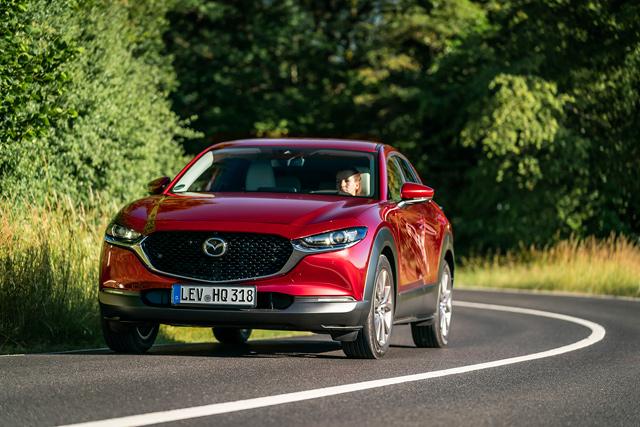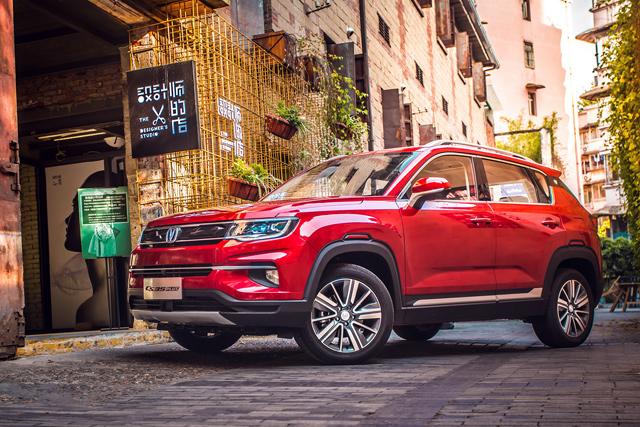You are here
Mazda CX-30: Distinctly Japanese with seamless style and delivery
By Ghaith Madadha - Jul 06,2020 - Last updated at Jul 06,2020

Photo courtesy of Mazda
The latest addition to the Hiroshima-based manufacturer’s Crossover SUV-heavy line-up, the Mazda CX-30 is a compact and convenient family vehicle that is strong on style and driving characteristics in what is an often humdrum segment of the modern automotive market. Created with subtly European flavours but a distinctly Japanese character, the CX-30 is Mazda’s second smallest crossover SUV and slots in between the CX-3 and CX-5 models, but forgoes the expected CX-4 moniker, as that is already occupied by a Chinese market model produced by Mazda in a joint venture with the FAW Group.
Dramatic demeanour
Designed with Mazda’s classy and contemporary “Kodo” design language, the Mazda CX-30 is characterised by its jutting fascia, lunging profile and athletically urgent sense of momentum. A dramatic design undoubtedly, the CX-30 seems to be in motion even when still and, like most modern Mazdas, has a distinctly sporting styling sensibility. However, the CX-30’s sportingly assertive style is fused with a smoothly flowing and wavy elegance in its lines, profile and surfacing, rather than taking the blunt, brash and overtly aggressive aesthetic approach to creating a dramatic intent and road presence.
Seemingly ready to sprint forward with its curt rear, high-set bulging rear lights and contrasting sharp-edged, shark-nosed front end with its deep-set lights, the CX-30’s front views are characterised by it huge concave grille and its textured diamond pattern. Slim, squinting and moody headlights meanwhile flank the grille and are browed by the CX-30’s jutting bonnet line, and underlined by chrome accents. Sporty and car-like in demeanour, the CX-30, however, features lower black cladding elements to lend it a chunkier SUV style, and to reduce the visual perception of body height.
Seamlessly linear
One of the more independently-minded and innovative car makers in engine technology, Mazda have in recent years been refining and honing the naturally-aspirated combustion engine. Named Skyactiv, Mazda’s engine technologies include high compression, direct injection, optimised gas flow, shortened combustion duration and piston cavities for improved efficiency and performance. Offering a more refined, smoother alternative that is more progressive, connected and responsive to precise driver input than either turbocharged or full hybrid alternatives, the CX-30 receives a 2-litre version of the 4-cylinder Skyactiv G engine, as driven in Jordan.
Mounted in front and driving the front wheels — as tested — through a slick shifting 6-speed automatic gearbox, the CX-30 develops 153BHP at 6,000rpm and 147lb/ft torque at 4,000rpm. Delivered with exacting throttle control and seamlessly smooth and linear accumulation, the CX-30’s driving characteristics are predictable and engaging, and allow one to dial in precise increments of power for a given situation or manoeuvre. Eager to rev and rewarding in engine character, the CX-30 can achieve 194km/h and is estimated to complete the 0-100km/h dash in around 10-seconds. Meanwhile, combined fuel consumption is estimated at 6.5l/100km.
Engaging abilities
Easily one of the best looking crossovers on the market, the Mazda CX-30’s power and performance do it justice in its segment as a compact and more affordable vehicle with convincing premium aspirations. And while we would certainly like to sample the more powerful CX-30 variants, the driven model’s progressive delivery and dynamic talents allow one to better explore and utilise its output. Featuring quick, precise electric-assisted steering the delivers good in-class road feel and tidy cornering turn-in, the CX-30 finds a fine line between cornering agility and adjustability, and commitment and confidence.
Well controlling body lean and with more direct steering than some rivals, it is however the CX-30’s good throttle control and progressively silky power build up that allows one to get back on the power early to smoothly, confidently and briskly exit onto a straight. Willing to adjust weight to the outside and rear when asked, the CX-30 can also easily tighten a cornering line. Offered with optional four-wheel-drive, the CX-30, however, proved more fluent and predictable in front-wheel-drive guise, as tested, than some all-wheel-drive segment rivals with a heavy front-drive bias.
Classy quarters
With progressive power delivery and without its driven rear wheels coming into play through cornering manoeuvres to alter dynamics, the CX-30 is among the best handling crossovers in its class. Driving through switchbacks and winding hill climbs with flow and finesse, it is also stable, refined and reassuring on highway, settled on rebound and in vertical travel, and is manoeuvrable and easy to drive in town. Standard to the CX-30 are stability and traction control, electronic brake-force distribution and rear parking sensors, while front sensors and a reversing camera are optional.
Though sharing no components, heritage or origin, and being of different eras, segments and price, the CX-30’s dramatic swooping style and adept dynamics were nevertheless reminiscent of a smaller Infiniti QX70, née FX. The CX-30’s premium aspirations are also pronounced inside, where it features a relaxed, comfortable, well-adjustable and involving driving position with classy fabric upholstery and easy to reach intuitive controls and stylish and uncluttered layouts. Comfortable if slightly firm riding, the CX-30’s cabin offers good space and practicality for young families, while materials and design have a subtly sporty and high quality look and feel.
TECHNICAL SPECIFICATIONS
Engine: 2-litre, transverse 4-cylinders
Bore x stroke: 83.5 x 91.2mm
Compression ratio: 10:1
Valve-train: 16-valve, DOHC, variable timing
Gearbox: 6-speed automatic, front-wheel-drive
Power, BHP (PS) [kW]: 153 (155) [114] @6,000rpm
Specific power: 76.5BHP/litre
Torque, lb/ft (Nm): 147.5 (200) @4,000rpm
Specific torque: 100.1Nm/litre
0-100km/h: 10-seconds (estimate)
Top speed: 194km/h
Fuel consumption, combined: 6.5-litres/100km (estimate)
Fuel capacity: 51-litres
Length: 4,395mm
Width: 1,795mm
Height: 1,540mm
Wheelbase: 2,655mm
Tread: 1,565mm
Overhang, F/R: 915/825mm
Ground clearance: 175mm
Headroom, F/R: 967/973mm
Shoulder room, F/R: 1,412/1,361mm
Hip room, F/R: 1,388/1,352mm
Luggage volume, min/max: 430-/1,406-litres
Kerb weight: 1,466kg (estimate)
Suspension, F/R: MacPherson struts/torsion beam
Steering: Electric-assisted rack & pinion
Turning circle: 11.36-metres
Brakes, F/R: Ventilated discs/discs
Tyres: 215/55R18
Price, on-the-road: Starting from JD26,300
Related Articles
A car-like compact crossover introduced for the 2020 model year, the Mazda CX-30 is a stylish and sporty addition to the Hiroshima-based man
One of the more independently-minded of mainstream car makers, Mazda’s ethos is one that emphasises a human-centric design, the Japanese man
A small, sporty convenient and compact crossover with quick responses and nimble handling, the Changan CS35 Plus is yet another impressive p














